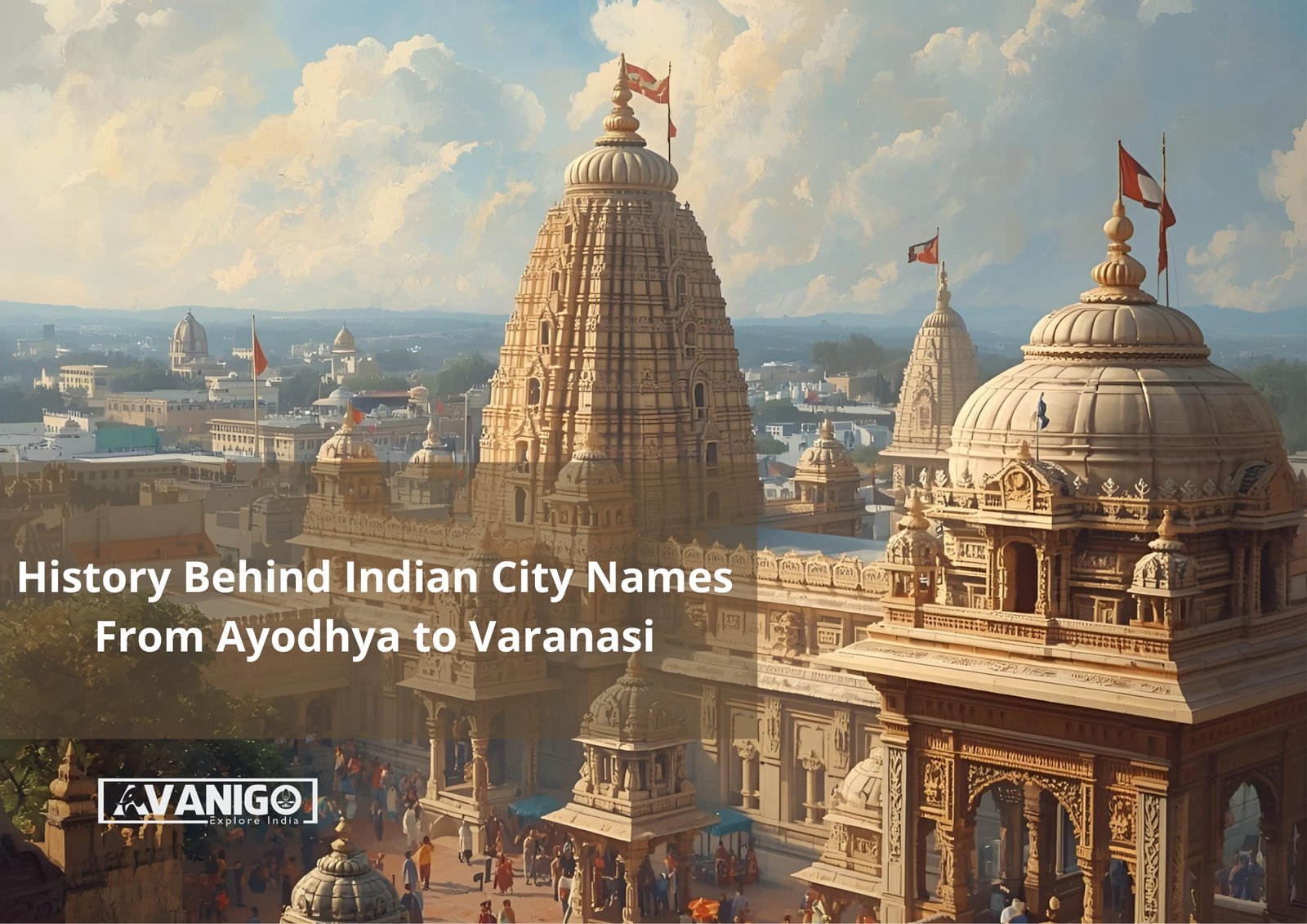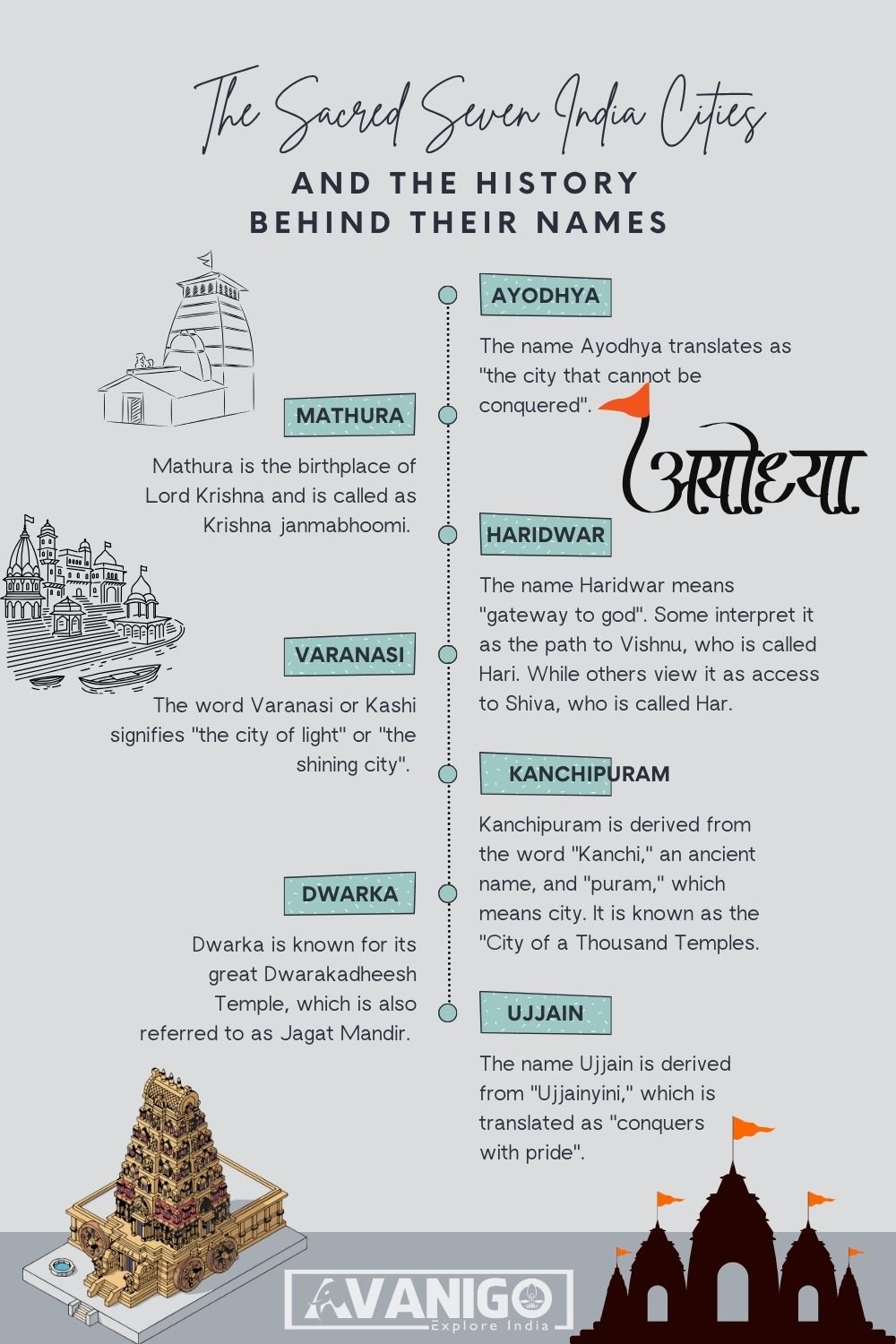 India is filled with cities and places that are sacred to Hinduism. These cities are not just different locations but are filled with many legends and stories about Gods and their devotees. But out of all these Indian cities, we discuss seven of them stand out. They are called Sapta Puri which means seven cities in Sanskrit. These cities are believed to bring nirvana for people who visit them in their lifetime.
India is filled with cities and places that are sacred to Hinduism. These cities are not just different locations but are filled with many legends and stories about Gods and their devotees. But out of all these Indian cities, we discuss seven of them stand out. They are called Sapta Puri which means seven cities in Sanskrit. These cities are believed to bring nirvana for people who visit them in their lifetime.
These seven cities have significant history associated with them. Also, their names are also based on Hindu puranas and epics. Here, we will read about the names of such ancient Indian cities and why Indian City Names are so as per Indian history.
Quick Navigation
The Sacred Seven Indian Cities and The History Behind Their Names
The stories of these cities are filled with fascinating myths and legends. Let’s take a closer look at them:
Ayodhya
Ayodhya is located in Uttar Pradesh, on the banks of the Sarayu River. The name Ayodhya translates as “the city that cannot be conquered”. The city is known as the birthplace of Lord Rama who is one of the most beloved Gods in Hinduism.
The epic Ramayana narrates the whole story of Rama. He was a prince who taught humankind the way of living with virtue and respect. Ayodhya is also known as “Ram Janmabhoomi”, which means “Rama’s birthplace”. Ayodhya’s Ram Mandir is one of the sacred places for Hindus.
Besides Ayodhya Ram Mandir, there are more than one hundred temples in the city. A few of the important ones are the Kanak Bhavan, which is devoted to Rama and Sita, and the Hanuman Garhi, which is a temple for Hanuman.
Ayodhya is also known for holy ponds and river banks called ghats. Brahma Kund, Sita Kund, and Rama Ghat, which is also known as Swargadwar are among them. Each of these places have stories of their own which you can know while visiting them.
Mathura
Mathura is the birthplace of Lord Krishna and is called as Krishna janmabhoomi. Krishna is also one of the most worshipped Gods in Indian culture. He is known for his loving nature, wisdom, and involvement in the epic of Mahabharata.
The name Mathura comes from ancient times. Some legends say that Shatrughna, the youngest brother of Rama, was the one who established this city. The archaeological evidence indicates that the area was inhabited as early as 1200 BC. You can witness the history of the city through the remnants of ancient pottery, tools, and sculptures.
Vrindavan is a place near Mathura where it is believed that Krishna spent his childhood. You can find hundreds of temples in this region dedicated to Krishna and Radha. People visit this city during festivals like Krishna Janmashtami and Holi when the city comes alive with celebrations.
Haridwar
The name Haridwar means “gateway to god”. Some interpret it as the path to Vishnu, who is called Hari. While others view it as access to Shiva, who is called Har. These two interpretations show how sacred this city is.
Haridwar is located where the Ganges River comes down from the Himalayas and first flows into the Indian plains. In Hinduism, the river is regarded as a goddess, Mother Ganga, who grants purity and blessings.
The most holy area in Haridwar is Har-Ki-Pauri, which literally means “Feet of Hari”. According to the history, here you can find the footprint of Lord Vishnu preserved on a rock.
During sunset, thousands of devotees gather at this ghat. They perform arti by floating small lamps on leaf holders with flowers in the river. It is accompanied by the ringing of bells, singing of prayers, and the whole place being filled with the aura of devotion.

Varanasi
Varanasi which is also called Kashi or Benares, is probably the most sacred of all the Hindu cities. The word Kashi signifies “the city of light” or “the shining city”. This city has been referred to by different names throughout history, such as Avimuktaka, Anandakanana, and Mahasmasana. The term Varanasi comes from the name of two rivers, Varuna and Asi, which flow into the Ganges and form the borders of the old city.
Varanasi is known as the city of Lord Shiva. Out of the twelve Jyotirlingas, the one in Varanasi is particularly significant. According to a story, Shiva once appeared here in the form of a boundless column of light. This incident took place where the Kashi Vishvanath Temple is located today.
The city is located on the western bank of the sacred Ganges. It has a total of eighty-one ghats where the pilgrims come to wash their sins away. The most significant ghats in Varanasi are Manikarnika Ghat, Harishchandra Ghat, Dashashwamedh Ghat, Assi Ghat, and Panchganga Ghat. Manikarnika and Harishchandra ghats are famous for cremating dead bodies. It is also believed that dying in Varanasi brings salvation to soul.
Old names and New Names of famous Indian cities
Kanchipuram
Kanchipuram is a city located in Tamil Nadu, next to the Palar River. Kanchipuram was the capital city during the Pallava Dynasty, which lasted from the sixth to the eighth centuries. Before that, it was the capital city of the early Cholas, who ruled from the second century BC.
Kanchipuram is derived from the word “Kanchi,” an ancient name, and “puram,” which means city. It is known as the “City of a Thousand Temples. Among them, it has around 108 temples for Shiva and 18 for Vishnu. Kanchi is one of the Ashta Dasha Sakthi Peethas, the most-powerful locations of Goddess Durga Devi.
The Kamakshi Amman Temple is the most famous temple in Kanchipuram. Kamakshi is one of the forms of Goddess Parvati, who is the wife of Shiva. According to a story, Kamakshi worshipped for many years to get Shiva’s love. Shiva was very pleased with her devotion and married her.
Kanchipuram also became a prominent learning and cultural hub. A Chinese monk, Xuanzang came and wrote about the city’s splendour during the period of the Pallavas. The city flourished under the rule of different empires, such as the Vijayanagara Empire and the Nayaka dynasty. The city Kanchi is known for its quality silks and cotton, one of the renowned handlooms of India.
Ujjain
Ujjain is a very old city located in the Madhya Pradesh. Its traditional name is Avantika. The name Ujjain is derived from “Ujjainyini,” which is translated as “conquers with pride”. There is a mythological tale related to this name.
As per the history, Lord Shiva vanquished the mighty demon king Tripurasura in this region. After the victory, Shiva gave the place a new name, Ujjainyini, to signify the victory of good over evil.
Ujjain is also among the places where one of the twelve Jyotirlingas are situated. Lord Shiva is worshipped in the form of Mahakala in Mahakaleshwar Temple. The holy linga is placed in this temple which is a three-story structure topped by a tall tower that rises into the sky.
The history of Ujjain is quite amusing too. It was the capital city of the ancient Avanti kingdom. Emperor Ashoka was the ruler of Ujjain during the third century BC. The glory of the city is so much that the famous poet Kalidasa said that the city is built by beings from heaven.
During the festivals like Maha Shivratri and Dusshera countless devotees visit this famous temple of India to take the blessings of Lord Shiva.
Dwarka
Dwarka is located at the western end of the Saurashtra peninsula in Gujarat, next to the Arabian Sea. This particular city has a strong bond with Lord Krishna.
After Krishna defeated Kansa, he moved to Dwarka and first set up his kingdom there. The Bhagavata Purana mentions that this event happened around five thousand years ago. It is also believed that the city was constructed by Vishwakarma and was known as heaven on earth.
Dwarka is known for its great Dwarakadheesh Temple, which is also referred to as Jagat Mandir. It is an impressive structure comprising seven floors and reaching up to 43 meters. From the seas below, the temple seems to be hovering over the Arabian Sea. Its tower holds a huge flag that measures 52 yards in length and consists of seven different colors.
To witness this marvel, you must visit this place once in your lifetime and take blessings of Lord Krishna.
Jagannath Puri Temple in Odisha
Conclusion
These seven cities and how the Indian city names arrived show that the geography of India is very much a part of its spirituality. The rivers, hills, and stones all have their share of stories. These cities are the passages to ancient knowledge, and the civilization. With this knowledge, we can harness respect for the divine in everything.
No matter if you go to these cities physically or through literature, the mythology associated with their names are still a source of inspiration. In future too, these seven holy towns will radiate like lights of faith and direct the spiritual seekers to moksha.
Swetha is a Content Specialist, LinkedIn Branding and B2B Marketing Consultant. When she is not in the world of B2B, she researches the roots and beauty of Indian Culture and Traditions. She is the author of the book: 365 Days 365 Posts – The Guide to LinkedIn Personal Branding, available exclusively on Amazon. Connect with her on LinkedIn.
